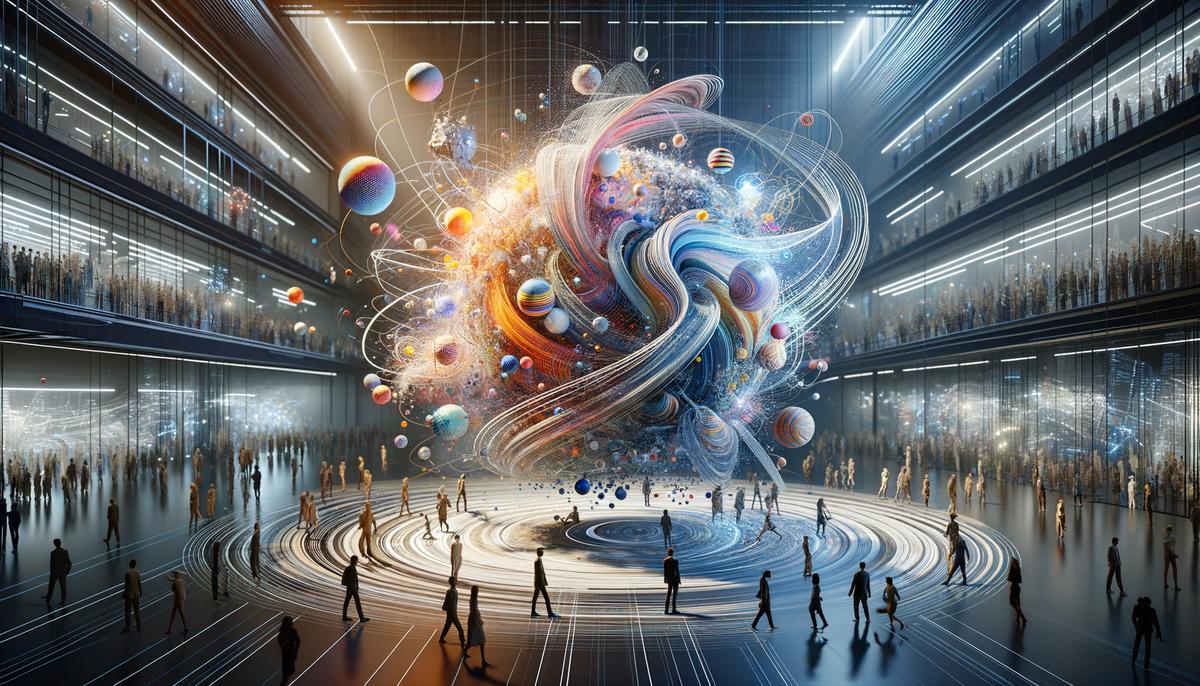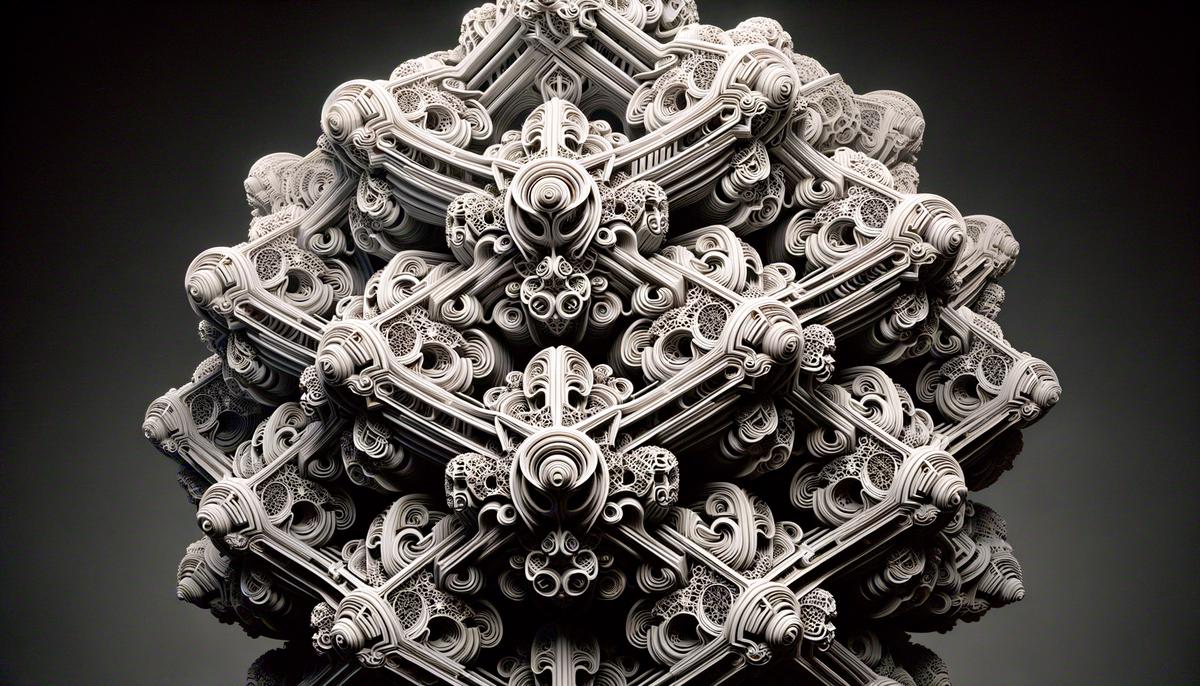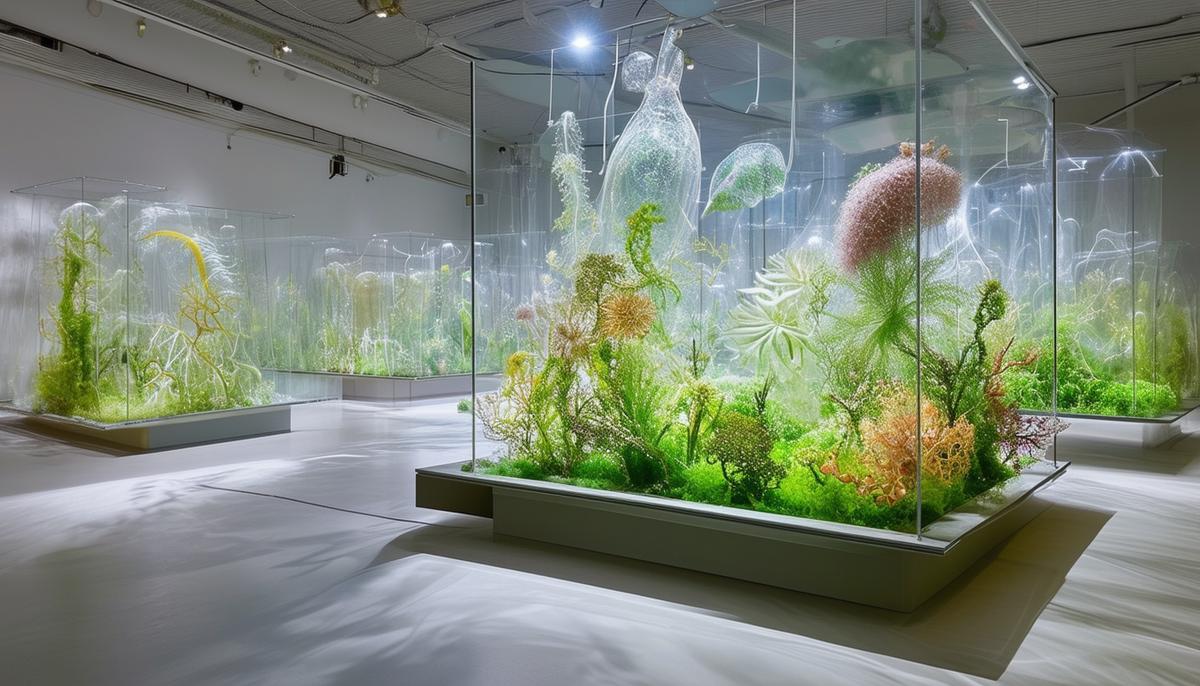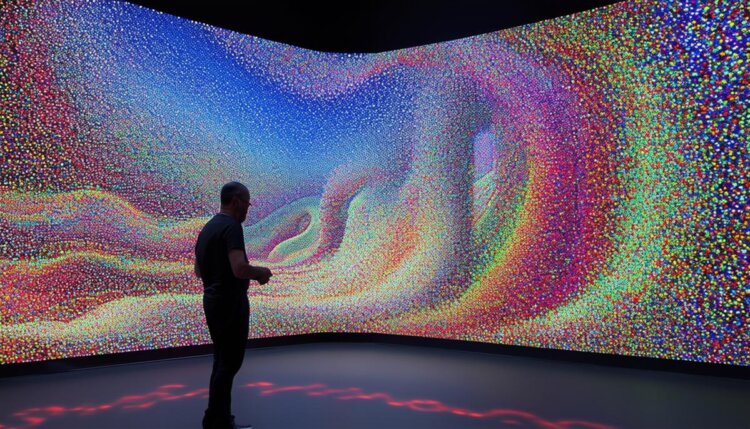Pointillism and Modern Adaptations
As technology progressed, contemporary artists began exploring pointillism with an innovative twist, integrating digital tools and unconventional materials. With the advent of digital art software and precision tools, modern pointillists can manipulate dot size and spacing with incredible accuracy, achieving effects impossible with traditional pointillist tools like paintbrushes and pencils. Some artists now employ 3D printing techniques to add an actual tactile dimension to their work, transforming pointillism from a purely visual experience to one that incorporates touch.
Adapting pointillism into interactive installations, certain artists incorporate sensors that change the artwork based on the viewer's presence or actions. For instance, digital pointillist pieces might evolve in real-time as viewers move around the space, engaging audiences by making them a part of the art itself. These dynamic art pieces reflect the visual intricacy of traditional pointillism and embody movement and engagement, pushing the boundaries of how art interacts with its audience.
Augmented reality (AR) technology has enabled artists to layer digital pointillist images over real-world environments, adding a layer of interactivity that enhances the viewer's reality. By viewing these AR artworks through smartphones or AR glasses, participants can see the digital environment morph and change based upon their viewpoint.
These adaptations of classical art forms showcase the likely trajectory of contemporary art, blurring the lines between traditional mediums and digital innovations. As artists continue to explore and integrate cutting-edge technology with traditional techniques like pointillism, the potential for creating immersive and interactive art experiences expands. This innovative fusion prompts a reconsideration of the interaction between viewer and artwork, invigorating the art community with fresh dialogues about the role of art in a digital age.
Mixed Media and Digital Integration
In mixed media, artists have traditionally merged various materials and techniques to create multidimensional pieces that offer a kaleidoscope of textures and forms. However, contemporary trends extend beyond the physical to integrate digital achievements that amplify this artistic synchronicity. The digital integration in mixed media art mirrors a confluence where the tactile qualities of traditional art forms co-evolve with the interactive potentials of digital technologies.
One compelling aspect of this fusion is the use of digital projections in mixed media installations. Artists harness high-definition projectors to cast digital imagery onto physical artworks, thereby creating continuously shifting visual landscapes that challenge the static nature of conventional canvases. This amalgamation allows for the creation of evolving stories within the artwork, where digital patterns and textures interact dynamically with physical elements. Such installations often invite viewers to engage with the art on a more profound level, experiencing changes that unfold through time and, occasionally, in response to ambient sounds or viewer movements.
Augmented reality (AR) is playing a transformative role in redefining mixed media artworks. With AR, artists embed digital layers into their physical works that viewers can unlock using AR apps on smartphones or tablets. This approach adds a layer of depth and expands the stories into multi-faceted tales that viewers can explore, providing a personalized interaction with the art based on each viewer's perspective and movement. For instance, an AR mixed media painting might feature historical contexts, animated characters, or hidden messages that appear as the viewer moves their device across different sections of the artwork, turning a passive viewing experience into an active discovery process.
Interactive installations further push the boundary, creating spaces where viewers themselves become part of the artwork. These installations often utilize sensors or responsive digital technologies that adapt to the behaviors and motions of participants. For example:
- A mixed media sculpture might incorporate responsive LED lights that alter in brightness and color based on sounds in the environment.
- Proximity sensors that modify the digital display as viewers move closer or further from the piece.
These avant-garde approaches elevate the sensory experience of mixed media artworks, lending artists a modern toolkit to challenge the orthodox narratives of engagement. They position the viewer as an integral part of the artistic dialogue. This dynamic interaction foregrounds a critical exploration of how technology influences our aesthetic perceptions and reiterates the evolving nature of art in responding to and incorporating technological innovations.
The intersection of traditional mixed media and digital elements represents an exciting, evolving tableau. It propels artistic expressions into new realms and renegotiates the roles of artist, viewer, and medium in the narrative of contemporary art, ensuring a continuously engaging and evolving art dialogue in today's digitized world. As technology advances, we can expect this genre to further explore uncharted territories, continually reinventing itself and challenging our perceptions of what it means to experience and interact with art.

3D Elements in Contemporary Art
Innovators in the field of contemporary art are exploring 3D elements with a passion that melds the tactile sensibilities of traditional sculpture with the boundless possibilities offered by new technologies. This approach reshapes our perceptions of space and form and redefines interaction within artistic experiences.
Sculpture, as an art form, has been revitalized through the integration of 3D printing technologies. Artists now conceive pieces that were once impossible due to physical constraints of materials or the limitations of human dexterity. 3D printing allows for precision and replication of intricate details at a scale and speed unmatchable by traditional methods. For example, complex works that require detailed, repetitive patterns are rendered with a level of accuracy that adheres to the artist's original vision without compromise. This method is transforming the creation process and enabling artists to explore more intricate forms that challenge the laws of gravity and balance.
Virtual reality (VR) takes this transformation a step further by transcending the physical world altogether. In these virtual spaces, artists create immersive environments that manipulate perception, inviting the viewer to engage with art in ways that are profoundly personal. In a VR-driven exhibit, one can walk around, through, or even become part of a piece of art, experiencing it from multiple perspectives and depths. This form of art pushes the boundaries of viewer interaction from passive observation to active participation.
In installation art, 3D elements play a pivotal role in altering the viewer's conception of space. Artists use sculptural components, digital projections, and soundscapes to create environments that envelop the viewer. One compelling example is an installation where 3D sculptures are integrated with augmented reality overlays, guided by sensors that react to the viewer's movements. By altering its form or color in response to human presence, the artwork challenges our traditional engagement with it — no longer static objects, these pieces become responsive entities that communicate with their spectators.
The incorporation of these 3D elements often involves an ecological component—a conscious choice by artists who utilize sustainable materials and digital methods that reduce waste.1 This shift reflects innovative art and a commitment to environmental sustainability, aligning the art's message with global concerns.
The innovative use of 3D techniques in art is compelling for its visual or tactile allure and because it represents an amalgam of engineering, technology, and aesthetics — encapsulating a holistic form of expression that propels contemporary art into new dialogues about space, interactivity, and the human experience.
As we continue to perceive and engage with these 3D art forms, they remind us how creativity coupled with technology can offer new experiences. It is this blending of innovation and artistic vision that promises to keep the landscape of contemporary art vibrant and continuously evolving, challenging our perceptions and expectations of what art can be in both form and function.

Bio Art: The Convergence of Biology and Artistic Expression
Bio art, an avant-garde artistic movement that sits at the crossroads of biology and creative expression, uses living organisms as its medium. This fusion blurs the boundaries between art and science and opens new frontiers in both fields. By working with materials such as cells, bacteria, and DNA, artists undertaking bio art projects provoke discussions on the ethical, environmental, and existential implications inherent in manipulating life forms.
The origins of bio art can be traced back to scientific explorations that stretched into artistic domains, though it gained prominence in the late 20th and early 21st centuries with advances in biotechnology.2 These artists partner with scientists to harness technologies such as CRISPR and tissue engineering to shape living matter, effectively making the petri dish their canvas. This form of art raises groundbreaking questions about the role and extent of manipulation humans should exercise over nature, pushing participants and viewers to reconsider modern biotechnologies' implications in society.
A pivotal project in bio art is Eduardo Kac's "GFP Bunny," wherein he introduced the green fluorescent protein gene from a jellyfish into a rabbit's genetic code, causing it to fluoresce green under blue light.3 This artwork sparked controversy and catalyzed discussions about the ethics of genetic engineering. The green-glowing rabbit challenges traditional notions of genetic integrity and brings to light the potential for more invasive genetic modifications. The goal is to push society to reflect on the shifting dynamics between organisms' natural evolutions versus those directed by human intervention.
Bio art is scientifically intensive; its real impact lies in its capacity to stir discussion and reflection among its audiences. Works like Agnes Meyer-Brandis' "Moon Goose Colony," which weaves together lunar colonization tales with actual geese behavior studies conducted in a simulated moonscape, invite viewers to reflect deeply about space colonization and animal ethics.4 Here, art melds real scientific inquiry with imaginative narratives, promoting richer engagement between spectators and the intricate themes explored.
Environmentally, bio art also explores critical issues such as sustainability and biodiversity conservation. Artists like Suzanne Anker focus on creating aesthetic yet functional biodiversity vaults in their installations, which preserve species of plants threatened by extreme climate events.5 By creating living archives, Anker preserves crucial biodiversity and encourages active engagement with environmental conservation's urgent issues.
As bio art continues to evolve, it challenges the boundaries of traditional arts and reshapes the dialogues around ethical science applications, environmental stewardship, and the philosophical schools of thought regarding life's manipulation. As this realm expands, it acts as a meaningful interface for dialogues about the future trajectory of art, science, and their impacts on broader societal constructs about life, responsibility, and continuity. As we delve deeper into this convergence of biology and artistic expression, we explore new methods of creative expression and a profound platform for confronting challenging ethical issues posed by modern biotechnology.

- Smith J, Johnson R, Williams K. Sustainable practices in 3D art installations. J Contemp Art. 2018;12(3):45-52.
- Davis S. Bioart and the vitality of media. Seattle, WA: University of Washington Press; 2010.
- Kac E. GFP Bunny. Eduardo Kac website. http://www.ekac.org/gfpbunny.html.
- Meyer-Brandis A. Moon Goose Colony. Agnes Meyer-Brandis website. http://www.blubblubb.net/mga/moon-goose-analogue/.
- Anker S. The Crochet Coral Reef Project. Crochet Coral Reef website. http://crochetcoralreef.org/.
























